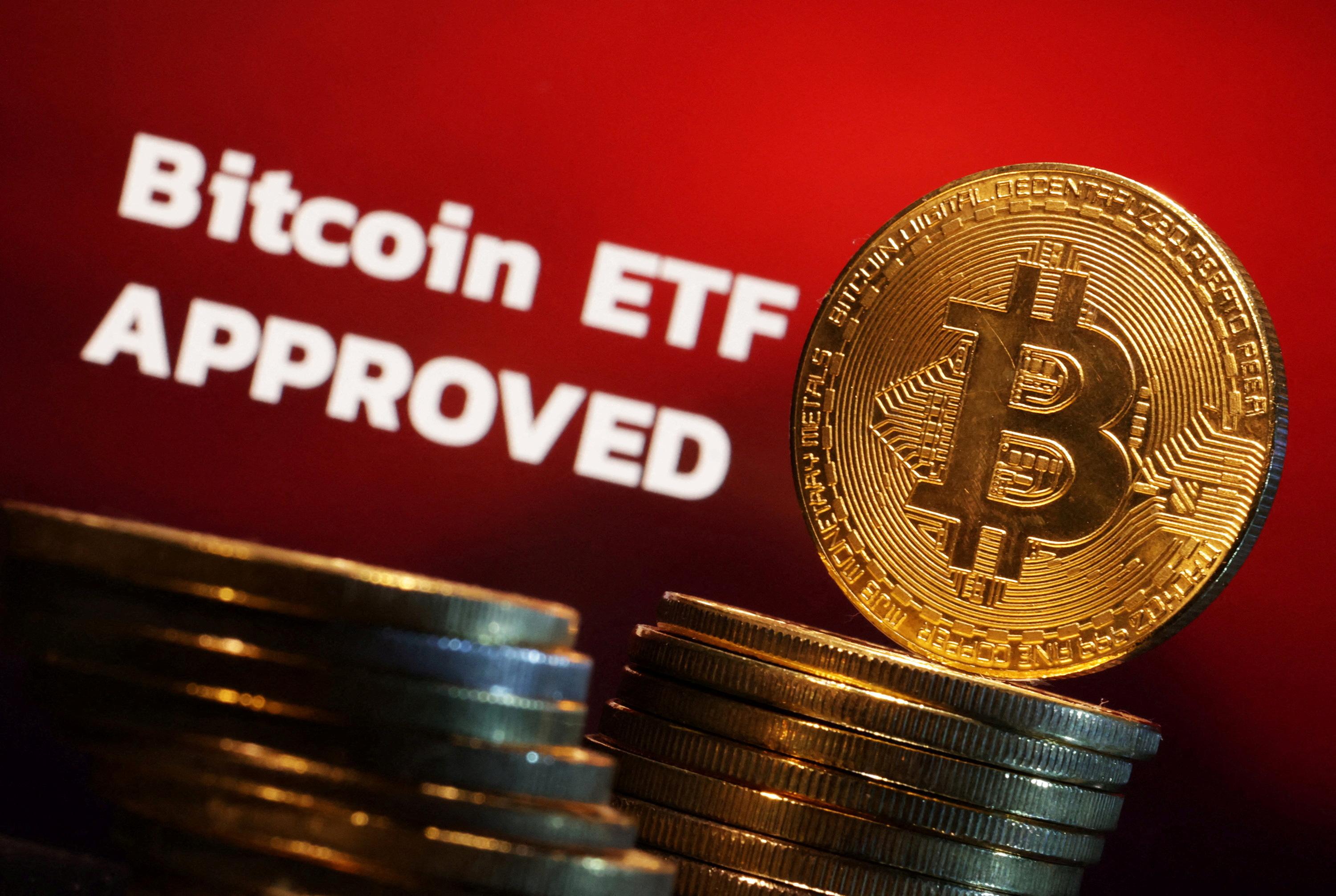In the ever-evolving landscape of cryptocurrency investment, a significant milestone was recently achieved: Bitcoin exchange-traded funds (ETFs) recorded an impressive influx of $1 billion in December alone. This remarkable surge not only underscores the increasing acceptance of Bitcoin as a mainstream asset but also highlights the growing appetite of investors looking to incorporate digital currencies into their portfolios. As the world of finance continues to grapple with the implications of blockchain technology and virtual currencies, this influx signals a pivotal moment for both seasoned investors and newcomers alike. What does this massive influx mean for the future of Bitcoin ETFs, the broader crypto market, and the traditional investment ecosystem? Join us as we delve into the factors behind this trend and explore its potential impact on the financial landscape.
Table of Contents
- Understanding the Surge in Bitcoin ETF Demand and Its Implications
- Analyzing the Factors Behind December’s Record Inflows
- Investment Strategies for Capitalizing on Bitcoin ETF Growth
- Future Trends: What the Billion-Dollar Milestone Means for Cryptocurrency Markets
- Q&A
- The Way Forward

Understanding the Surge in Bitcoin ETF Demand and Its Implications
The recent surge in demand for Bitcoin ETFs has underscored a significant shift in investment strategy among both institutional and individual investors. With inflows reaching an impressive $1 billion in December alone, the market is witnessing a growing appetite for cryptocurrency exposure via regulated platforms. This trend could be attributed to several factors:
- Market Accessibility: Bitcoin ETFs provide a more straightforward way for traditional investors to engage with cryptocurrency without navigating wallets and exchanges.
- Regulatory Clarity: Increased regulatory acceptance has bolstered confidence among investors, paving the way for safer investment vehicles.
- Portfolio Diversification: As more investors seek to hedge against inflation or market volatility, Bitcoin has emerged as a potential asset class in diversified holdings.
These dynamics have led many market analysts to speculate about the longer-term implications of this rising trend. The entry of more institutional capital could lead to increased price stability and legitimacy for Bitcoin as a mainstream asset. Below is a brief comparison of the recent inflow trends versus historical data:
| Month | Inflows ($ Million) |
|---|---|
| January | 200 |
| February | 150 |
| March | 300 |
| April | 400 |
| December | 1,000 |
This significant influx indicates a clear upward trajectory not only for Bitcoin ETFs but for the entire cryptocurrency market, suggesting potential for further growth as investors increasingly look to capitalize on the digital asset boom.

Analyzing the Factors Behind December’s Record Inflows
December’s impressive surge in Bitcoin ETF inflows can be attributed to a combination of market dynamics and investor behavior. Key factors behind this phenomenon include:
- Year-End Tax Planning: Investors often look to optimize their tax positions as the year closes, and inflating their crypto holdings via ETFs offers a streamlined solution.
- Institutional Adoption: A noticeable increase in interest from institutional investors has played a crucial role, as larger entities seek to diversify their portfolios with Bitcoin exposure.
- Market Sentiment: A bullish sentiment surrounding Bitcoin prices, driven by positive events such as major endorsements and regulatory clarity, has fueled this influx.
Furthermore, macroeconomic trends have also contributed significantly. Investors are increasingly wary of inflationary pressures, compelling them to explore alternative assets like Bitcoin. Noteworthy factors include:
- Inflation Hedging: With rising inflation rates, Bitcoin is being perceived as a digital gold, attracting both retail and institutional investors.
- Accessibility Improvements: A growing number of platforms offering easier access to Bitcoin ETFs has lowered the barriers for entry, making it simpler for new investors to join the market.
| Factor | Impact |
|---|---|
| Year-End Tax Planning | Increase in investor activity |
| Institutional Adoption | Higher asset inflows |
| Inflation Concerns | Shift towards Bitcoin as a hedge |

Investment Strategies for Capitalizing on Bitcoin ETF Growth
As investors turn their sights toward Bitcoin ETFs following impressive inflows, it becomes essential to adopt strategic methods that align with this burgeoning trend. Consider diversifying your investment portfolio to integrate Bitcoin ETFs alongside traditional assets. This approach can help mitigate risk while still allowing for significant exposure to cryptocurrency markets. Key strategies to contemplate include:
- Dollar-Cost Averaging: This technique involves investing a fixed amount in Bitcoin ETFs at regular intervals, smoothing out the volatility over time.
- Segmenting Investments: Allocating a portion of your assets to Bitcoin ETFs specifically can enhance potential returns without overexposing your portfolio to a single asset class.
- Monitoring Regulatory Changes: Staying informed about legal and regulatory developments surrounding Bitcoin ETFs will help you make timely decisions and capitalize on market shifts.
Moreover, incorporating technological tools into your investment strategy can provide valuable insights. Utilizing analytical platforms can help track ETF performance and market sentiment. When analyzing Bitcoin ETFs, keep an eye on the following key indicators:
| Indicator | Importance |
|---|---|
| Trading Volume | Higher volumes can indicate greater market confidence. |
| Price Trends | Understanding price movements can help identify optimal entry and exit points. |
| Asset Under Management (AUM) | A growing AUM can reflect increasing investor interest and market validation. |

Future Trends: What the Billion-Dollar Milestone Means for Cryptocurrency Markets
The recent influx of $1 billion into Bitcoin ETFs marks a significant trend in the financial landscape, showcasing a growing institutional interest in cryptocurrency. This monumental milestone not only highlights the increasing acceptance of Bitcoin as a legitimate asset class but also reflects the broader sentiment that digital assets are becoming a cornerstone of diversified investment portfolios. As regulatory frameworks continue to evolve, investors are increasingly seeing Bitcoin ETFs as safer entry points into the volatile cryptocurrency market, leading to a surge in demand.
Furthermore, this substantial capital shift indicates potential for greater market stabilization and liquidity. Moving forward, we may witness several noteworthy implications:
- Increased Institutional Adoption: Financial giants could further embrace digital currencies, leading to enhanced trust among traditional investors.
- Spark for Innovation: With more funds entering the space, we can expect a wave of new products and services from fintech firms catering to this growing market.
- Bullish Market Sentiment: As more significant capital is funneled into Bitcoin, prices may experience upward pressure, attracting a wider retail audience.
Q&A
Q&A: Bitcoin ETFs Hit $1 Billion in December Inflows
Q1: What are Bitcoin ETFs and why are they significant?
A1: Bitcoin Exchange-Traded Funds (ETFs) are investment vehicles that allow investors to gain exposure to Bitcoin without directly purchasing the cryptocurrency. They are significant because they provide a regulated method for institutional and retail investors to participate in the Bitcoin market, offering a level of security and convenience that direct ownership may lack.
Q2: What does it mean that Bitcoin ETFs saw $1 billion in inflows in December?
A2: The $1 billion inflow indicates a strong interest and demand for Bitcoin ETFs during December. This influx of capital suggests that investors are increasingly confident in the cryptocurrency market, viewing Bitcoin as a viable investment option. It can also be seen as a trend towards greater acceptance of Bitcoin in mainstream finance.
Q3: What factors contributed to the surge in Bitcoin ETF inflows during December?
A3: Several factors may have contributed to this surge, including a general rally in cryptocurrency prices, increased mainstream media attention, and growing acceptance of Bitcoin among institutional investors. Additionally, year-end investment strategies and the optimism surrounding regulatory developments could have motivated investors to allocate funds into Bitcoin ETFs.
Q4: How do these inflows compare to previous months or years?
A4: December’s inflows mark a significant milestone, especially when compared to historical trends. Prior months often saw more modest inflows, highlighting December as a peak period for investment. This increase reflects not only the recovering market sentiment but also a broader shift towards digital assets as part of diversified portfolios.
Q5: What are the implications of this growth for the Bitcoin market?
A5: The growth in Bitcoin ETF inflows could lead to increased price stability and liquidity in the Bitcoin market. More institutional involvement typically means enhanced credibility for Bitcoin as an asset class, which might attract even more investors. On a broader scale, this trend could signify a maturation of the cryptocurrency market, paving the way for future products and services targeting digital assets.
Q6: Are there any risks associated with investing in Bitcoin ETFs?
A6: Like any investment, Bitcoin ETFs carry risks, including market volatility, regulatory changes, and the inherent risks associated with the underlying asset, Bitcoin. Although ETFs can mitigate some risks by providing diversified exposure, investors should conduct thorough research and consider their risk tolerance before investing.
Q7: What does the future hold for Bitcoin ETFs and the broader cryptocurrency market?
A7: The future of Bitcoin ETFs appears promising, with potential for further growth and innovation in the sector. As regulatory frameworks evolve and more financial products emerge, investor confidence might continue to climb. However, the cryptocurrency market remains fickle, so continuous monitoring and adaptation will be essential for both investors and companies seeking to capitalize on this dynamic landscape.
The Way Forward
As we close the chapter on December, the milestone of Bitcoin ETFs reaching $1 billion in inflows serves as a pivotal moment in the evolving narrative of cryptocurrency. This surge not only underscores the growing acceptance of digital assets within mainstream finance but also highlights the shifting sentiments of investors navigating an ever-changing landscape. With central banks and regulatory bodies poised to influence the future of money, the impact of Bitcoin ETFs may ripple through the financial world, inviting both scrutiny and excitement. As we embark on a new year, the stage is set for further developments in this arena, providing fertile ground for discussion, innovation, and potential growth. Whether you’re a seasoned investor or a curious observer, the saga of Bitcoin and its burgeoning role in the financial ecosystem is one to watch closely.

9p3zoq
buy ivermectin 12mg for humans – purchase carbamazepine order carbamazepine 200mg pills
order isotretinoin 40mg pills – order isotretinoin for sale order generic linezolid
buy amoxicillin medication – order valsartan 80mg pills buy ipratropium 100 mcg
order zithromax 500mg without prescription – buy bystolic paypal bystolic medication
purchase omnacortil online – buy azithromycin 500mg generic prometrium 100mg price
order gabapentin 800mg pills – gabapentin 800mg pill sporanox 100 mg cheap
cheap lasix – order nootropil 800 mg generic betnovate oral
order generic doxycycline – order albuterol pills oral glucotrol
clavulanate uk – buy ketoconazole no prescription buy cymbalta generic
buy augmentin 1000mg pill – cymbalta 20mg price order duloxetine sale
buy rybelsus without prescription – order rybelsus 14 mg pills purchase cyproheptadine pills
zanaflex uk – zanaflex ca hydrochlorothiazide 25mg generic
order sildenafil without prescription – cost cialis 5mg cialis 40mg over the counter
buy generic tadalafil 20mg – buy cialis 40mg pills buy sildenafil online
buy cenforce pills for sale – cenforce 100mg canada purchase glucophage for sale
buy generic lipitor online – buy amlodipine 5mg for sale purchase zestril sale
buy omeprazole 10mg sale – buy atenolol 100mg sale how to buy atenolol
purchase depo-medrol generic – aristocort over the counter brand triamcinolone 10mg
clarinex price – claritin online buy priligy 90mg over the counter
misoprostol 200mcg oral – buy orlistat pills diltiazem online
order zovirax online – order zovirax 800mg generic order rosuvastatin 10mg sale
domperidone buy online – sumycin 250mg oral cyclobenzaprine without prescription
motilium tablet – buy flexeril 15mg for sale buy cyclobenzaprine without a prescription
inderal us – how to get propranolol without a prescription where can i buy methotrexate
coumadin medication – buy warfarin pills buy cozaar 50mg without prescription
buy esomeprazole cheap – sumatriptan 50mg oral sumatriptan without prescription
levaquin usa – buy levaquin medication zantac 300mg for sale
buy meloxicam online – flomax us order generic flomax 0.4mg
purchase ondansetron online – order zofran pills zocor cheap
order valtrex sale – valtrex generic buy fluconazole 100mg generic
More content pieces like this would make the blogosphere more useful.
order provigil 200mg order modafinil 100mg pills provigil 100mg oral order modafinil 200mg pills buy modafinil 200mg generic buy provigil pill modafinil 100mg sale
More posts like this would bring about the blogosphere more useful.
Thanks on putting this up. It’s understandably done.
zithromax 250mg sale – buy metronidazole paypal purchase metronidazole online
buy rybelsus 14 mg without prescription – semaglutide 14mg cost buy periactin paypal
domperidone pill – tetracycline medication purchase cyclobenzaprine generic
inderal 10mg sale – order clopidogrel pills methotrexate 5mg tablet
amoxicillin online buy – purchase ipratropium generic combivent pills
order zithromax for sale – order bystolic sale bystolic price
order augmentin – https://atbioinfo.com/ buy acillin online cheap
nexium 40mg cost – nexiumtous buy esomeprazole 20mg sale
order coumadin 5mg generic – https://coumamide.com/ cozaar 50mg pills
order generic meloxicam – relieve pain mobic 7.5mg canada
deltasone online buy – apreplson.com order deltasone 10mg generic
low cost ed pills – fastedtotake best ed medications
order amoxil for sale – comba moxi cheap amoxicillin sale
forcan brand – this forcan online
escitalopram 10mg drug – anxiety pro purchase escitalopram
cenforce 100mg ca – https://cenforcers.com/# cheap cenforce 50mg
what does a cialis pill look like – cialis vs flomax for bph black cialis
cialis contraindications – https://strongtadafl.com/# tadalafil and sildenafil taken together
buy generic ranitidine 150mg – click zantac pills
purple viagra 100 – https://strongvpls.com/# where to buy viagra in canada
This is the compassionate of literature I in fact appreciate. click
Palatable blog you procure here.. It’s hard to find great status script like yours these days. I honestly comprehend individuals like you! Go through guardianship!! https://buyfastonl.com/gabapentin.html
The thoroughness in this break down is noteworthy. https://ursxdol.com/get-metformin-pills/
I’ll certainly bring back to read more. https://prohnrg.com/product/orlistat-pills-di/
More posts like this would force the blogosphere more useful. https://aranitidine.com/fr/acheter-cenforce/
Thanks for putting this up. It’s understandably done. https://ondactone.com/simvastatin/
I couldn’t hold back commenting. Profoundly written!
purchase clopidogrel pill
More posts like this would prosper the blogosphere more useful. https://lzdsxxb.com/home.php?mod=space&uid=5065815
brand forxiga 10mg – https://janozin.com/ where to buy dapagliflozin without a prescription
buy orlistat for sale – site order xenical generic
Greetings! Jolly serviceable recommendation within this article! It’s the scarcely changes which will make the largest changes. Thanks a lot for sharing! http://bbs.yongrenqianyou.com/home.php?mod=space&uid=4277929&do=profile
You can conserve yourself and your family close being alert when buying prescription online. Some pharmaceutics websites control legally and provide convenience, secretiveness, sell for savings and safeguards to purchasing medicines. buy in TerbinaPharmacy https://terbinafines.com/product/zantac.html zantac
Thanks on putting this up. It’s okay done. TerbinaPharmacy
Эта публикация дает возможность задействовать различные источники информации и представить их в удобной форме. Читатели смогут быстро найти нужные данные и получить ответы на интересующие их вопросы. Мы стремимся к четкости и доступности материала для всех!
Получить дополнительные сведения – https://vivod-iz-zapoya-1.ru/
I am actually delighted to coup d’oeil at this blog posts which consists of tons of worthwhile facts, thanks object of providing such data.
Immediate Olux Review
Immediate Olux se demarque comme une plateforme d’investissement crypto de pointe, qui met a profit la puissance de l’intelligence artificielle pour fournir a ses clients des atouts competitifs majeurs.
Son IA etudie les marches financiers en temps reel, detecte les occasions interessantes et met en ?uvre des strategies complexes avec une precision et une vitesse hors de portee des traders humains, optimisant ainsi les potentiels de rendement.
Clarte Nexive Review
Clarte Nexive se distingue comme une plateforme d’investissement crypto de pointe, qui exploite la puissance de l’intelligence artificielle pour fournir a ses clients des atouts competitifs majeurs.
Son IA scrute les marches en temps reel, identifie les opportunites et execute des strategies complexes avec une finesse et une celerite inatteignables pour les traders humains, augmentant de ce fait les potentiels de rendement.
TurkPaydexHub
TurkPaydexHub se differencie comme une plateforme de placement crypto de pointe, qui met a profit la puissance de l’intelligence artificielle pour fournir a ses clients des avantages decisifs sur le marche.
Son IA etudie les marches financiers en temps reel, repere les opportunites et met en ?uvre des strategies complexes avec une exactitude et une rapidite hors de portee des traders humains, optimisant ainsi les potentiels de rendement.
TurkPaydexHub se distingue comme une plateforme d’investissement crypto revolutionnaire, qui met a profit la puissance de l’intelligence artificielle pour proposer a ses membres des atouts competitifs majeurs.
Son IA scrute les marches en temps reel, detecte les occasions interessantes et execute des strategies complexes avec une finesse et une celerite inaccessibles aux traders humains, augmentant de ce fait les perspectives de gain.
Домашний визит особенно уместен при затянувшемся употреблении, когда нарастают тревожные вегетативные симптомы (тремор, потливость, сердцебиение), появляются проблемы со сном и «качели» давления, но при этом сохранён контакт, нет выраженной дыхательной недостаточности и глубокой дезориентации. Преимущества очевидны: экономия времени (нет дороги и ожидания), психологический комфорт, меньше сенсорных триггеров (яркий свет, шум), возможность сразу настроить режим первой «тихой ночи». Технологически выездная бригада оснащена как приёмный кабинет: инфузомат для точной скорости капания, пульсоксиметр, глюкометр, кассеты Na?/K?, портативный кардиомонитор с возможностью регистрации ЭКГ, набор проверенных средств для коррекции тошноты и защиты слизистой. Если во время триажа выявляются «красные флаги» — риск судорог, падение сатурации, признаки делирия, нестабильная гемодинамика, — мы организуем перевод в стационар «КубаньМедЦентра» без задержек и с непрерывностью терапии.
Углубиться в тему – http://narcolog-na-dom-krasnodar14.ru
Комплексное применение этих средств ускоряет процесс восстановления.
Подробнее тут – [url=https://narkolog-na-dom-sankt-peterburg14.ru/]нарколог на дом срочно в санкт-петербурге[/url]
Современная наркология — это не набор «сильных капельниц», а точные инструменты, управляющие скоростью и направлением изменений. В «НеваМеде» технологический контур работает тихо и незаметно для пациента, но даёт врачу контроль над деталями, от которых зависит безопасность.
Узнать больше – http://narkologicheskaya-klinika-v-spb14.ru/
«Как отмечает врач-нарколог Павел Викторович Зайцев, «эффективность терапии во многом зависит от своевременного обращения, поэтому откладывать визит в клинику опасно»».
Узнать больше – [url=https://narkologicheskaya-klinika-sankt-peterburg14.ru/]наркологическая клиника клиника помощь санкт-петербург[/url]
Эти шаги помогают системно подойти к проблеме и обеспечить максимальную эффективность лечения.
Изучить вопрос глубже – [url=https://vyvod-iz-zapoya-ryazan14.ru/]вывод из запоя недорого[/url]
Вызов нарколога на дом сочетает медицинскую эффективность с удобством. Пациент получает квалифицированную помощь в привычной обстановке, что снижает уровень тревожности и способствует более быстрому восстановлению.
Изучить вопрос глубже – http://narkolog-na-dom-sankt-peterburg14.ru
Наш подход строится на двух принципах: минимально достаточная фармакотерапия и прозрачные «коридоры безопасности». Это означает — никаких «универсальных капельниц» и полипрагмазии. Каждый компонент в схеме имеет проверенную цель: восполнить жидкость, выровнять электролиты, защитить слизистую, снизить вегетативный «шторм» и вернуть возможность естественного сна. Скорость и объём инфузий мы задаём инфузоматом, контролируя давление, пульс, сатурацию и самочувствие на каждом этапе.
Подробнее можно узнать тут – [url=https://vyvod-iz-zapoya-v-ryazani14.ru/]наркология вывод из запоя[/url]
«НеваМед» — частная наркологическая клиника в Санкт-Петербурге, где клиническая точность сочетается с бережной коммуникацией и безусловной конфиденциальностью. Мы делаем лечение не «разовым визитом ради капельницы», а продуманным маршрутом, в котором каждый шаг имеет понятную цель, сроки оценки и прозрачные критерии эффективности. Для пациента это означает предсказуемость первых суток, сохранение личного пространства и ощущение контролируемой динамики, а для близких — ясные правила помощи без тревожных импровизаций.
Выяснить больше – [url=https://narkologicheskaya-klinika-v-spb14.ru/]наркологическая клиника клиника помощь[/url]
Домашний визит особенно уместен при затянувшемся употреблении, когда нарастают тревожные вегетативные симптомы (тремор, потливость, сердцебиение), появляются проблемы со сном и «качели» давления, но при этом сохранён контакт, нет выраженной дыхательной недостаточности и глубокой дезориентации. Преимущества очевидны: экономия времени (нет дороги и ожидания), психологический комфорт, меньше сенсорных триггеров (яркий свет, шум), возможность сразу настроить режим первой «тихой ночи». Технологически выездная бригада оснащена как приёмный кабинет: инфузомат для точной скорости капания, пульсоксиметр, глюкометр, кассеты Na?/K?, портативный кардиомонитор с возможностью регистрации ЭКГ, набор проверенных средств для коррекции тошноты и защиты слизистой. Если во время триажа выявляются «красные флаги» — риск судорог, падение сатурации, признаки делирия, нестабильная гемодинамика, — мы организуем перевод в стационар «КубаньМедЦентра» без задержек и с непрерывностью терапии.
Ознакомиться с деталями – https://narcolog-na-dom-krasnodar14.ru/narkolog-i-psikhiatr-v-krasnodare
Нарколог на дом в Санкт-Петербурге — это востребованная медицинская услуга, позволяющая получить помощь в комфортных домашних условиях. Такой формат особенно актуален в ситуациях, когда пациент не может или не хочет обращаться в стационар. Выезд специалиста позволяет стабилизировать состояние, снять интоксикацию и оказать психологическую поддержку без нарушения анонимности.
Подробнее тут – http://narkolog-na-dom-sankt-peterburg14.ru
Современная наркология — это не набор «сильных капельниц», а точные инструменты, управляющие скоростью и направлением изменений. В «НеваМеде» технологический контур работает тихо и незаметно для пациента, но даёт врачу контроль над деталями, от которых зависит безопасность.
Подробнее можно узнать тут – [url=https://narkologicheskaya-klinika-v-spb14.ru/]наркологическая клиника нарколог в санкт-петербурге[/url]
Вывод из запоя в Рязани является востребованной медицинской услугой, направленной на стабилизацию состояния пациента после длительного употребления алкоголя. Специалисты применяют современные методы детоксикации, позволяющие быстро и безопасно восстановить жизненно важные функции организма, снизить проявления абстинентного синдрома и предотвратить осложнения. Процесс лечения осуществляется в клинических условиях под постоянным наблюдением врачей.
Выяснить больше – [url=https://vyvod-iz-zapoya-ryazan14.ru/]вывод из запоя[/url]
«Как отмечает врач-нарколог Павел Викторович Зайцев, «эффективность терапии во многом зависит от своевременного обращения, поэтому откладывать визит в клинику опасно»».
Подробнее тут – http://narkologicheskaya-klinika-sankt-peterburg14.ru
https://t.me/s/Top_BestCasino/173
https://t.me/s/officials_pokerdom/3902
https://t.me/s/Irwin_officials
https://t.me/s/RejtingTopKazino
https://t.me/s/Martin_casino_officials